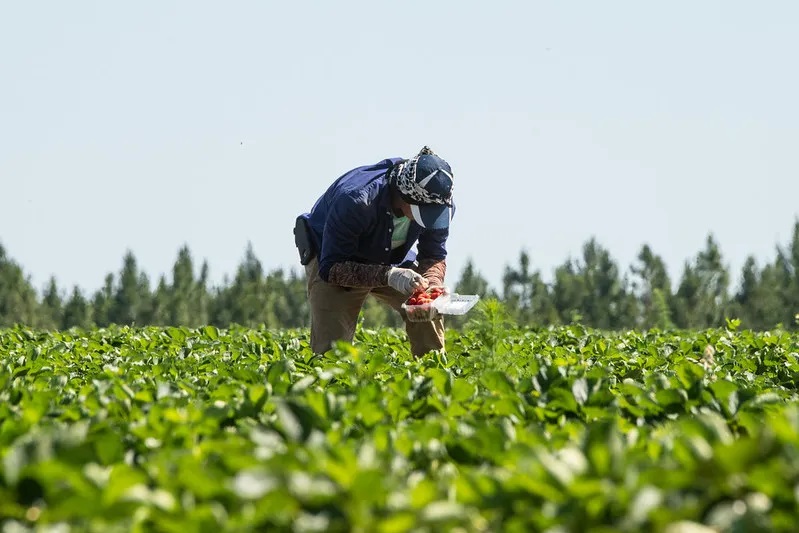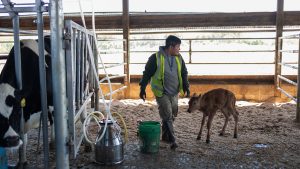
In response to the agriculture industry declaring a growing labor shortage, the U.S. House Agriculture Committee released a report on the H-2A guest worker program that outlines 20 specific recommendations.
The recommendations, detailed in a 23-page report released on March 7 by the committee’s Agricultural Labor Working Group, promise to expedite visa application procedures, loosen some program regulations, adjust wage calculations, and set a federal standard on heat exposure for H-2A workers. The working group consists of the same number of Republicans and Democrats.
“We are losing farms in America at a rapid pace, and there is no question that our broken workforce system is partly to blame,” said Zippy Duvall, president of the American Farm Bureau Federation, in a statement on its website.

Farmworker advocates said the proposals, especially the changes to how worker pay could be calculated, would hurt farmworkers financially. Farmworkers already make low wages.
“Farmworkers need stronger protections and opportunities for permanent legal status to stabilize the agricultural workforce,” said Alexis Guild, vice president of strategy and programs at Farmworker Justice, one of the stakeholders the committee met with.
Another farmworker advocacy group, the Mexico-based Centro de los Derechos del Migrante, said it opposed the proposals.
“The recommendations … will harm H-2A and U.S. workers alike by reducing farm workers’ wages,” said Francisco Diaz, the group’s communications and media relations lead, in a statement. “We shared information about the H-2A program and identified priority concerns for the Agricultural Labor Working Group in a letter. Unfortunately, the final recommendations do not address the majority of the issues we raised, and fall short of providing the solutions needed to truly stabilize the agricultural workforce.”

It’s unclear when the recommendations might become legislation that the full U.S. House of Representatives can vote on.
The Midwest, which encompasses six of the nation’s top 10 most agriculture-intensive states, has witnessed a more than 4% decline in the number of farms since 2017 — more than 30,000, according to the 2022 Census of Agriculture, the latest one released.
The National Farm Bureau estimates that about 2.4 million farm jobs need filling. A survey conducted by the House committee’s working group confirmed that farms and ranches are betting on bringing in foreign labor to meet their operations’ needs because they rate domestic labor as inadequate.
“Production ag and processing facilities cannot staff their businesses adequately with domestic workers. Non-native workers are the backbone of the U.S. ag industry,” one of the answers reads.
The Census of Agriculture reveals that migrants comprise approximately 16% of farmworkers across the United States. In the Midwestern states, the proportion of migrant labor in the agricultural workforce is slightly lower, at 5%, representing 28,806 workers.
Possible solutions
The H-2A visa program enables nonimmigrant foreign workers to undertake temporary agricultural jobs in the U.S. According to data from the Department of Homeland Security, the program has seen a dramatic increase in use, reaching 378,513 certified positions in fiscal year 2023.
However, according to a survey conducted by the committee, the H-2A program often fails to meet the needs of many U.S. farmers, particularly those involved in year-round operations such as dairy and livestock farming.
Out of the 20 recommendations in the report, 15 received unanimous support from a bipartisan group of lawmakers, while the remaining five garnered majority support.
Six recommendations focused on simplifying and streamlining the visa application process for companies, such as creating a single internet-based electronic portal for filing H-2A application proposals.
The committee members suggest allowing employers seeking H-2A workers to apply with staggered entry dates for greater flexibility. Additionally, they propose simplifying the hiring process by permitting farmers and producers to post job listings in an electronic registry, moving beyond the traditional newspaper print advertisements. (H-2A job listings are already available on the U.S. Department of Labor’s website.)
They also recommend a permanent exemption from the in-person interview requirement for returning H-2A workers, streamlining their re-entry and reducing bureaucratic hurdles.
Most of the 356 respondents to the committee’s survey said that wages and costs are the number one issue that Congress or the administration should prioritize.
One key recommendation seeks to modify the H-2A wage calculation to make it more flexible for employers, ensuring that employees do not automatically receive the higher wage rate for any task performed throughout the day. For example, if a worker whose primary task is picking fruit but spends any part of the workday driving a truck, they must be compensated at the truck driver rate for the entire day.
The report recommends removing mid-contract wage adjustments, thereby sparing employers the need to alter contract workers’ wage rates during the 12-month contract period.
The report also suggests a strategy to minimize significant variations in H-2A farmworker wages: implement a wage freeze in 2025, setting the wages for that year based on the levels from 2024.
From 2025 to 2029, wage changes would be tightly controlled. They are not allowed to decrease by more than 1.5% or increase by more than 3.25% annually, except if the resulting wage falls below 110% of the federal or state minimum wage, in which case an additional increase may apply.
From 2030 onward, wage adjustments would be capped, with decreases not exceeding 1.5% and increases limited to 3.25%. The Secretaries of Agriculture and Labor would evaluate whether to extend the wage control measures.

“The wage reform recommendations in the Agricultural Labor Working Group report would harm H-2A and U.S. workers,” said Guild of Farmworker Justice.
She argued that the proposals risk lowering the wages for both H-2A and U.S. workers, directly contradicting the program’s fundamental mandate to avoid negatively impacting domestic workers’ wages and working conditions.
The committee also proposed expanding the H-2A program’s reach to encompass tasks associated with the early stages of preparation, processing, or manufacturing in sectors like livestock, poultry, dairy, peanuts, sugar beets, and sugarcane — sectors not presently covered by the program.
Additionally, they advocated for the implementation of a federal heat rule for H-2A workers. Since 2021, OSHA has been developing a heat-stress regulation that mandates employers ensure sufficient water and rest breaks for outdoor workers.
You can now read the most important #news on #eDairyNews #Whatsapp channels!!!
🇺🇸 eDairy News INGLÊS: https://whatsapp.com/channel/0029VaKsjzGDTkJyIN6hcP1K



















